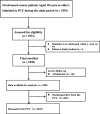Prevalence of falls in the last weeks of life and relationship between falls, independence and quality of dying in Japan: a large prospective cohort study
- PMID: 39486828
- PMCID: PMC11529517
- DOI: 10.1136/bmjopen-2024-085315
Prevalence of falls in the last weeks of life and relationship between falls, independence and quality of dying in Japan: a large prospective cohort study
Abstract
Objective: This study aims to determine the frequency of falls and their serious complications in palliative care units (PCUs), as well as explore the complex interplay between falls, independence and quality of dying.
Design: A prospective cohort study.
Setting and participants: The dying process of patients with advanced cancer in 23 PCUs in Japan.
Outcome measures: Palliative care specialist physicians recorded whether patients experienced falls, serious complications from falls, activities that led to falls, independence (workability in the last days and use of indwelling urinary catheter) and Good Death Scale as an indicator of quality of dying.
Results: Of the 1633 patients evaluated, 150 patients (9.2%; 95% CI 7.8% to 11%) experienced falls within 30 days prior to death. The patients who fell were mostly men, had Eastern Cooperative Oncology Group performance status 3 on admission, a longer estimated prognosis on admission and delirium during hospitalisation. Serious falls causing fractures or intracranial haemorrhages were rare in five patients (0.3%; 95% CI 0.038% to 0.57%). The most common reason for falls was the need to use the toilet (64.7%). The Good Death Scale and indwelling urinary catheter use were not significantly associated with falls (p=0.34; p=0.34).
Conclusion: Falls occur in approximately 10% of patients in PCUs, but serious complications are rare. The relationship between falls, independence and quality of dying is complex, that is, a fall may not be necessarily bad, if it is the result of respect for the patient's independence. Healthcare providers need to consider fall prevention while supporting patients' desire to move on their own to maintain independence.
Keywords: Nurses; PALLIATIVE CARE; Patient-Centered Care.
© Author(s) (or their employer(s)) 2024. Re-use permitted under CC BY-NC. No commercial re-use. See rights and permissions. Published by BMJ.
Conflict of interest statement
Competing interests: None declared.
Figures
References
Publication types
MeSH terms
LinkOut - more resources
Full Text Sources
Medical
Research Materials

